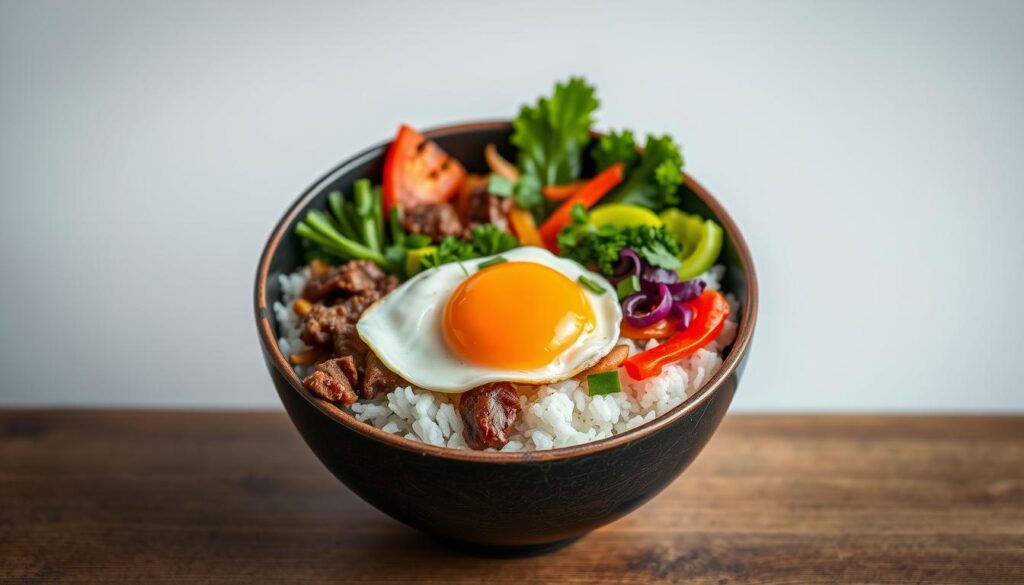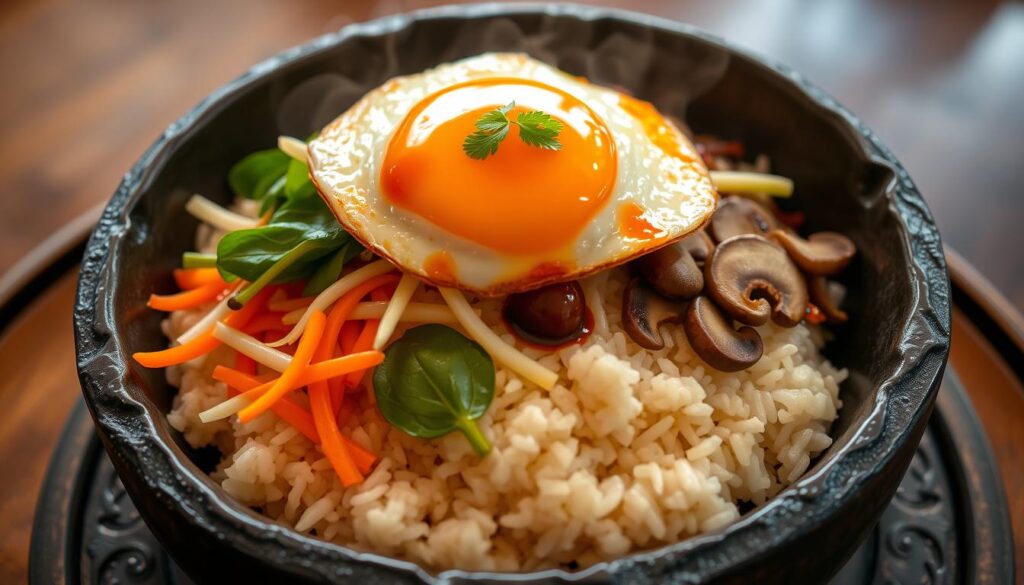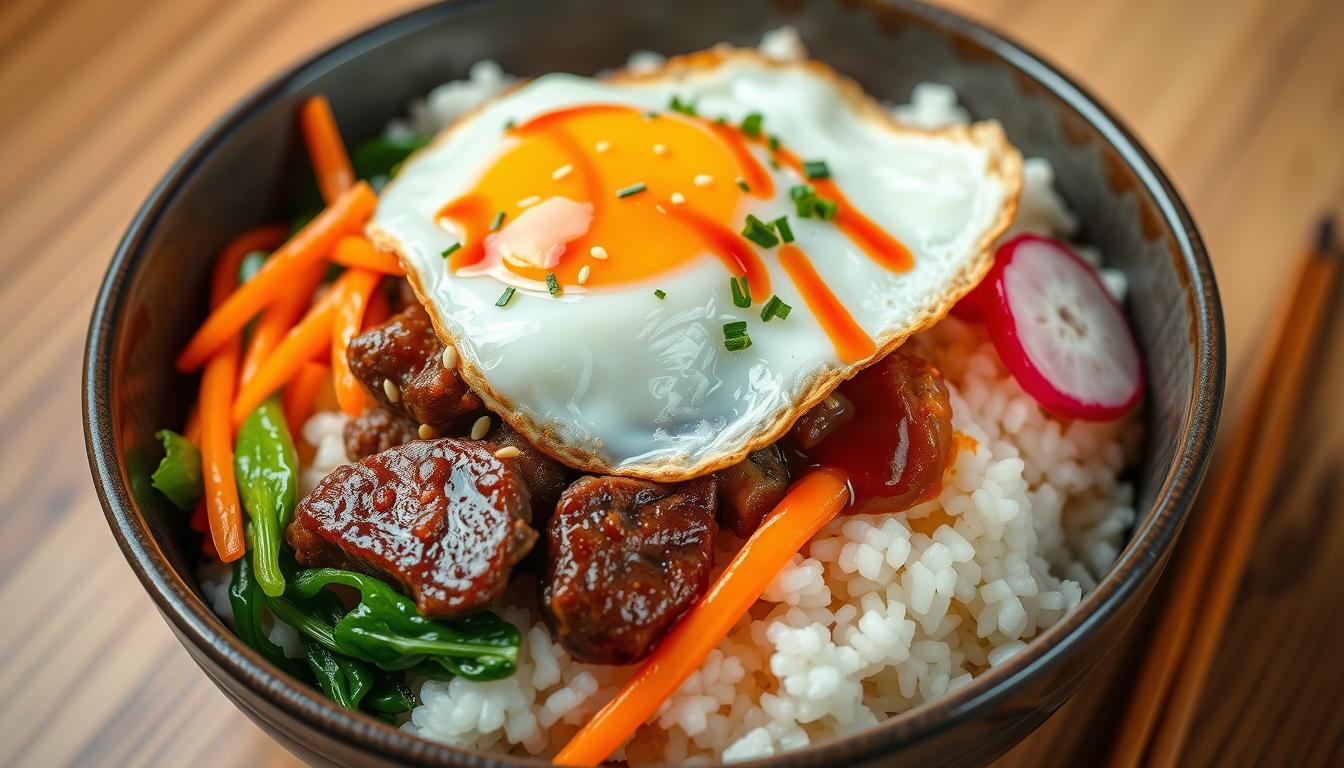Make Authentic Korean Breakfast Bibimbap Recipe at Home
Imagine starting your day with a nutritious and flavorful meal that combines the best of Korean cuisine. Bibimbap, which translates to “mixed rice,” is a signature Korean dish that has gained international recognition for its simplicity and versatility.
You can create your own version of this beloved dish at home, tailored to your dietary preferences and ingredient availability. The beauty of bibimbap lies in its flexibility, allowing you to mix and match various vegetables, meats, and seasonings to create a meal that’s both nourishing and delicious.
By mastering the art of preparing bibimbap, you’ll not only be treating yourself to a culinary delight but also exploring the rich cultural heritage behind this iconic Korean dish.
Key Takeaways
- Learn how to create a traditional Korean mixed rice dish at home.
- Understand the cultural significance of bibimbap in Korean cuisine.
- Discover the fundamental components of a classic rice bowl.
- Explore the balance of flavors and textures in bibimbap.
- Master the techniques for preparing each component to achieve restaurant-quality results.
What is Bibimbap? The Korean Mixed Rice Bowl
Bibimbap is more than just a meal; it’s an experience that showcases the beauty of Korean cuisine through its vibrant colors and diverse ingredients. At its core, bibimbap is a simple yet profound dish that represents the essence of Korean cooking: a bowl of rice mixed with various toppings.
You are about to explore a dish that is not only delicious but also rich in cultural significance. Bibimbap, which translates to “mixed rice” in English, is a quintessential Korean dish consisting of rice topped with an assortment of individually prepared vegetables, protein, and gochujang sauce. The name “bibimbap” literally reflects how the dish is meant to be enjoyed – by mixing all components together before eating.
The Cultural Significance of Bibimbap in Korean Cuisine
Bibimbap embodies the Korean principle of harmony through its balanced combination of colors, textures, and flavors. In Korean culture, bibimbap represents the importance of community and sharing, as it’s often prepared for family gatherings and celebrations. The arrangement of ingredients in a circle represents the harmony of yin and yang in Korean philosophy, extending the cultural significance beyond taste.
| Component | Description | Significance |
|---|---|---|
| Rice | The base of the dish | Foundation of the meal |
| Vegetables | Assortment of seasoned vegetables | Provides color, texture, and flavor |
| Protein | Often beef or egg | Adds richness and depth |
| Gochujang Sauce | Spicy chili pepper paste | Brings heat and flavor |
By understanding the components and cultural context of bibimbap, you can appreciate the depth and richness it brings to the table. This dish is not just a meal; it’s a representation of Korean culinary philosophy and community values.
Essential Ingredients for Authentic Korean Breakfast Bibimbap
Gathering the right ingredients is the first step towards making an authentic Korean Breakfast Bibimbap. The dish is known for its vibrant presentation and diverse flavors, which are achieved by combining a variety of ingredients.
The Rice Foundation
The foundation of any authentic bibimbap is short-grain white rice, which provides the perfect sticky texture that binds all ingredients together. While traditional recipes call for white rice, you can also use brown rice or cauliflower rice as alternatives.
Vegetable Components
Traditional vegetable components include seasoned spinach, bean sprouts, julienned carrots, zucchini, shiitake mushrooms, and Korean radish (mu). Each vegetable is prepared separately to maintain its distinct flavor and texture, contributing to the overall harmony of the dish.
Protein Options
Protein options vary from traditional raw or marinated beef (bulgogi) to more accessible alternatives like ground beef, thinly sliced chicken, or tofu for vegetarian versions. Marinating the protein enhances its flavor, making it a crucial step in preparing bibimbap.
The Signature Gochujang Sauce
The signature gochujang sauce, made from Korean fermented chili paste, adds the characteristic sweet, spicy, and umami flavor that ties all components together. This sauce is a crucial element that elevates the dish, providing a depth of flavor that is unmistakably Korean.
Preparing the Bibimbap Components
Preparing the components of bibimbap is a labor of love that requires attention to detail. Each element, from the rice to the vegetables and protein, must be prepared separately to maintain its distinct flavor, texture, and color.
Cooking Perfect Rice for Bibimbap
To achieve the ideal sticky yet firm texture essential for bibimbap, rinse short-grain rice thoroughly until the water runs clear. Then, cook it with slightly less water than usual. This method ensures that the rice is perfectly cooked and ready to be the foundation of your bibimbap.
Seasoning and Cooking the Vegetables
Vegetables are a crucial component of bibimbap, and they must be prepared with care. For spinach, bring a large saucepan filled three-quarters full with water to a boil over medium-high heat. Add 1 teaspoon of kosher salt and 1 pound of spinach in 2 batches. Cook, stirring occasionally, until wilted, about 2 minutes. Drain the spinach and, when cool enough to handle, squeeze out as much water as possible. Finely grate 1 clove of garlic onto the spinach, season with 1/2 teaspoon of kosher salt, and drizzle with 1 tablespoon of sesame oil. Mix well with your hands until combined.
Other vegetables like bean sprouts are boiled until tender yet still crunchy. Carrots and zucchini are typically julienned and quickly stir-fried over high heat with a touch of salt to maintain their vibrant colors and crisp texture. Shiitake mushrooms are sautéed with soy sauce until they develop a rich, meaty flavor.
| Vegetable | Cooking Method | Seasoning |
|---|---|---|
| Spinach | Blanched | Garlic, Salt, Sesame Oil |
| Bean Sprouts | Boiled | Salt |
| Carrots and Zucchini | Stir-fried | Salt |
| Shiitake Mushrooms | Sautéed | Soy Sauce |
Preparing the Protein
Protein preparation varies depending on the choice. Beef is typically marinated in a mixture of soy sauce, sesame oil, garlic, and sugar before being quickly cooked over high heat. This method ensures that the beef is flavorful and cooked to perfection.
Making Homemade Gochujang Sauce
The homemade gochujang sauce is made by combining fermented chili paste with sesame oil, sugar, water, and toasted sesame seeds. This blend creates a balanced sweet-spicy flavor that complements the other components of bibimbap.
As you prepare each component, arrange them separately on a plate or tray. This allows you to assemble the final dish with artistic precision, ensuring that your bibimbap is not only delicious but also visually appealing.
Authentic Korean Breakfast Bibimbap Recipe
To make an authentic Korean breakfast bibimbap, follow this straightforward recipe that serves 3-4 people and can be prepared in about 40 minutes. This dish is a harmonious combination of flavors, textures, and colors, making it a delightful start to your day.
Ingredients List
The ingredients for this recipe are carefully selected to provide a balanced and nutritious meal. You’ll need:
- 3 cups of short-grain white rice
- 100g (3.5 ounces) of beef mince (optional)
- Assortment of vegetables: 250g seasoned spinach, 350g seasoned bean sprouts, 100g shiitake mushrooms, 120g carrots
- Seasonings: 1 Tbsp soy sauce, 1 Tbsp sesame oil, 1 tsp brown sugar, 1/4 tsp minced garlic, 1/2 tsp fine sea salt
- 3 or 4 eggs
- Cooking oil
- Toasted seasoned seaweed
- For bibimbap sauce: 2 Tbsp gochujang, 1 Tbsp sesame oil, 1 Tbsp sugar, 1 Tbsp water, 1 Tbsp roasted sesame seeds, 1 tsp vinegar, 1 tsp minced garlic
| Ingredient | Quantity |
|---|---|
| Short-grain white rice | 3 cups |
| Beef mince (optional) | 100g |
| Seasoned spinach | 250g |
| Eggs | 3 or 4 |
Step-by-Step Cooking Instructions
Begin by cooking the rice according to package instructions, aiming for a slightly sticky consistency. While the rice cooks, prepare each vegetable separately. Blanch the spinach for 2 minutes, then season with salt, garlic, and sesame oil. Boil bean sprouts until they’re tender yet crisp. Sauté julienned carrots and mushrooms with appropriate seasonings.
For the protein component, marinate the beef in a mixture of soy sauce, sesame oil, sugar, and garlic for at least 15 minutes. Then, cook it over medium-high heat until browned. Prepare the gochujang sauce by mixing all the ingredients until smooth.
Fry eggs sunny-side up, keeping the yolks runny as they’ll create a creamy sauce when mixed with the other ingredients. To assemble, place warm rice in individual serving bowls, arrange the vegetables and meat in separate sections around the perimeter, and crown with a fried egg in the center.

Assembly Tips for Beautiful Presentation
The visual presentation is crucial for bibimbap. Aim for a colorful arrangement that showcases each ingredient before mixing. Place the ingredients in a harmonious pattern, and garnish with toasted seasoned seaweed if desired. This attention to detail will elevate your dining experience and make the dish more enjoyable.
Serving and Eating Bibimbap the Korean Way
The traditional Korean way of serving bibimbap is a feast for the eyes as well as the taste buds. When served, bibimbap is arranged artfully in individual bowls, creating a visually appealing presentation.
Traditional Accompaniments
In Korean tradition, bibimbap is often accompanied by various side dishes. These may include kimchi, which adds a tangy spice, and dongchimi (radish water kimchi) for a refreshing contrast. Other accompaniments can be miyeokguk (seaweed soup) to cleanse the palate and various banchan (small side dishes) such as seasoned seaweed, pickled vegetables, and marinated tofu served on the side.
The Art of Mixing Bibimbap
To enjoy bibimbap, you need to mix it. The proper way to eat bibimbap involves breaking the egg yolk and mixing all the ingredients thoroughly with chopsticks until the rice takes on the color of the sauce. Koreans typically serve additional sauce on the side, allowing diners to adjust the spice level to their preference. The mixing process is considered an essential part of the bibimbap experience, as it allows all flavors to meld together while coating the rice with the sauce and egg yolk.
Bibimbap Variations to Try
The beauty of bibimbap lies in its adaptability to various tastes and dietary needs. You can experiment with different ingredients and presentation styles to create unique versions of this traditional Korean dish.
Dolsot Bibimbap
Dolsot bibimbap, or hot stone bowl bibimbap, is a variation served in a sizzling hot stone bowl. This method creates a crispy rice crust at the bottom, known as “nurungji,” and continues to cook the ingredients as you eat. To make dolsot bibimbap, preheat the stone bowl until it’s extremely hot, then coat it with sesame oil before adding rice and toppings.

Vegetarian and Vegan Options
You can easily make vegetarian or vegan bibimbap by substituting or omitting certain ingredients. For a vegetarian version, omit the meat and add protein-rich alternatives like tofu, tempeh, or extra shiitake mushrooms. For vegan versions, ensure your gochujang sauce is free from animal products and omit the egg.
- Use a variety of colorful vegetables to add texture and flavor.
- Experiment with different types of protein sources like marinated tofu.
Regional Korean Variations
Korea’s different regions offer unique twists on bibimbap, reflecting local ingredients and preferences. For example, Jeonju Bibimbap is famous for its high-quality ingredients and complex preparation, featuring raw egg yolk and yukhoe (raw beef tartare). Other regional variations include Andong Bibimbap with mackerel and Tongyeong Bibimbap with fresh seafood.
Tips for Making Restaurant-Quality Bibimbap at Home
Elevate your bibimbap game by following these expert tips for a restaurant-quality dish at home. Achieving an authentic Korean bibimbap experience requires attention to detail and proper preparation of each component. To make delicious bibimbap, it’s essential to understand the importance of preparation and timing.
Ingredient Substitutions for American Kitchens
For those without access to Korean ingredients, there are suitable substitutes. You can replace gochujang with a mixture of miso paste and sriracha, Korean radish with daikon, and perilla leaves with shiso or basil. These substitutions will help you achieve a similar flavor profile to traditional bibimbap.
- Substitute gochujang with miso paste and sriracha
- Use daikon instead of Korean radish
- Replace perilla leaves with shiso or basil
Make-Ahead and Storage Suggestions
Time management is crucial when making bibimbap. Prepare all vegetables in advance and store them separately to maintain their distinct colors and textures. You can cook the vegetables up to 3 days ahead and store them in the refrigerator. When you’re ready to serve, simply warm the rice and assemble the bibimbap. The gochujang sauce can be made up to a week ahead and stored in an airtight container in the refrigerator.
- Cook vegetables quickly over high heat to preserve their vibrant colors and crisp textures
- Store all vegetables separately to maintain their textures
- Make gochujang sauce up to a week ahead and store it in the refrigerator
Conclusion
By following this guide, you’ve not only learned a recipe but also gained insight into the cultural significance of bibimbap in Korean cuisine. The process of making authentic Korean breakfast bibimbap recipe at home allows you to experience the harmonious balance of flavors, textures, and colors that define this traditional dish. The gochujang sauce brings together the assorted vegetables, rice, and meat in a symphony of flavors. As you enjoy your bibimbap in a single bowl, remember that the act of mixing everything together symbolizes harmony and balance, central values in Korean culture. Drizzling sesame oil and sprinkling sesame seeds adds a final touch to this nutritious meal.
Mastering bibimbap connects you to centuries of Korean cooking traditions. Whether you’re using various vegetables or adding your preferred protein, the versatility of bibimbap makes it adaptable to your preferences. With rice as the foundation and the savory sauce as the cornerstone, this dish is a true representation of Korean mixed rice traditions.

